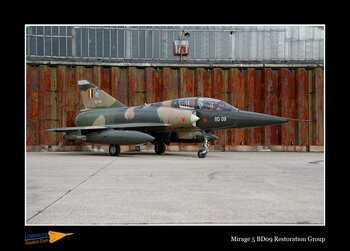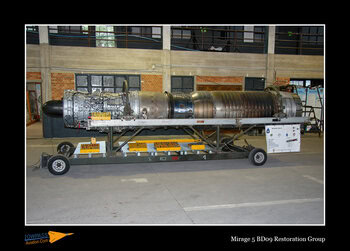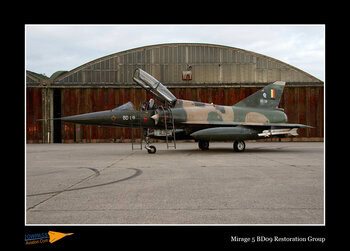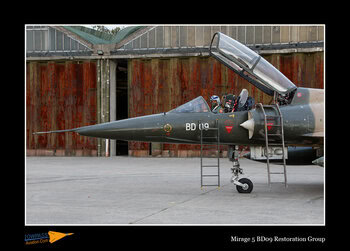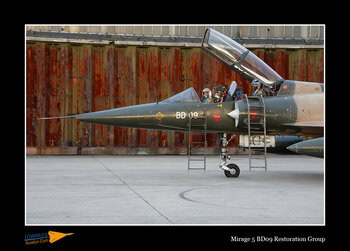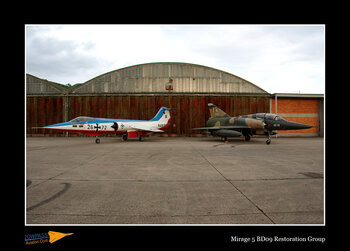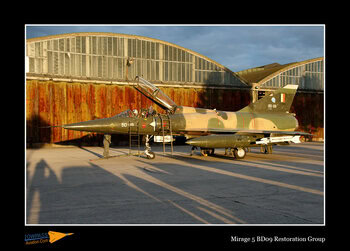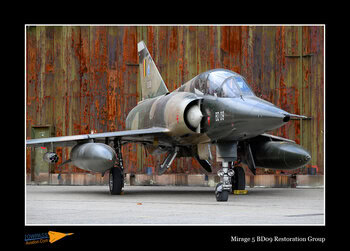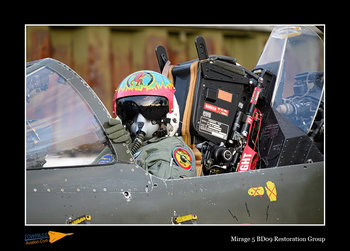History, current and future of Mirage 5 BD09 Restoration Group:
Mirage 5, with Belgian Air force serial BD09, rolled out of the factory on 25 March 1971 and it belonged to 8 Squadron. During the following years the aircraft flew it’s missions for 1, 2, 8 and 42 Squadron within the Belgian Air Force. During its last flight on 13 January 1994 the aircraft belonged to 42 Squadron which was based at Weelde airbase. In total the Mirage had 3.846 flying hours and 3.930 landings. After a few years of storage at Weelde the aircraft was transported to the French company SAGEM in Paris on 15 December 1998. SAGEM was a company involved in defense electronics, consumer electronics and communication systems. On 8 February 2013 it was exposed in Paris for auction by Rétromobile.
The aircraft finally arrived at Brustem on 1 February 2018 where it was placed in hangar 43 until it was moved to Droneport Hangar on 10 March 2020. The Droneport hangar was very modern and due to the limited space in this hangar the Mirage 5 BD09 Restoration Group was searching for a solution with more space and luckily this solution was found in Hangar 27. Hangar 27 is an old hangar which was used years ago by the Belgian Air Force as maintenance hangar when they still operated from Brustem/Sint Truiden, this old hangar fits the Mirage 5 more than the modern Droneport hangar. After months of very hard work by the Restoration Group the Mirage moved from Droneport to Hangar 27 on 4 October 2022. In Hangar 27 the group has enough space to expose the Mirage 5 and all other equipment like an engine, ejection seats, helmets, suits, logbooks, patches and many more historical pieces they have collected over the year. All those historical pieces are on display is a small museum in Hangar 27. Hangar 27 also has a bar for some foods and drinks, a lounge room and restrooms. The Mirage 5 BD09 Restoration Group holds several open days during the year and Hangar 27 is a multi-purpose hall for concerts, festivals, parties, conventions, seminars, corporate events, conferences, photo shoots, personal or professional celebrations.
Since August 2019 it’s possible to enjoy a “Sensation Flight” try a Mirage in its virtual world! Step into a historic Mirage fighter jet, put on a VR headset and embark on a thrilling virtual flight. Experience formation flying, navigate to targets like your own home, and perform exhilarating aerobatics. Don’t miss the chance to take a supersonic Mach 2.2 night flight over Belgium at 2400 km/h! Enjoy a 360° spectacle in a fully immersive cockpit. Soak up the vibrant atmosphere and explore our incredible surroundings. During the years this virtual flight has been updated. 11 January 2024 was a special day for the Mirage 5 BD09 Restoration Group, the cockpit of Mirage 5 BA27 arrived at Hangar 27. The cockpit has been lying safely in a barn for years.
The Group was working on this part of the aircraft when the BA27 Cockpit Club was born which was the basis of the BD09 Restoration Group. On 13 July 2024, during an open day, the cockpit of Mirage 5 BR22 arrived at Hangar 27. This cockpit section was used as a garden-ornament in a residential garden at Bougival, France. With the arrival of this cockpit the Group has all three types of Mirage 5 that served within the Belgian Air Force.
Mirage V in Belgian service
In 1963, Belgium ordered 112 Lockheed F-104 Starfighters. Yet that number of aircraft was not sufficient to re-equip the Belgian Air Force’s entire fighterbomber fleet. This was also the case for the Netherlands and both countries were forced to acquire a number of additional aircraft to replace the aging Republic F-84F Thunderstreak. The Dutch as well as the Norwegians took a swift decision and chose the American Northrop F-5, while the Royal Danish Air Force opted for the Swedish Saab Draken.
In February 1968, the Belgian government selected the Dassault Mirage 5, mainly based on economic considerations, including in particular the co-production options available to the nation’s aeronautical industry. The Mirage 5 was in fact a Mirage III without radar, which allowed for carrying more fuel. This Mach 2 fighter had to be converted to a fighter-bomber; quite a challenge for the staff and the units concerned. Dassault received an order of 106 aircraft, among which were 16 two-seaters and 27 single-seaters re-configured for the reconnaissance role. The recce aircraft had five cameras in the nose, two each looking port and starboard and another downwards. The first Mirage M5 B (official name) landed at Florennes Air Base on June 30, 1970.
In total Belgium acquired 63 Mirage 5BA, 27 Mirage 5BR and 16 Mirage 5BD. The Mirage 5BA was optimized for ground attacks, the Mirage 5BR was specifically developed for the aerial reconnaissance
Licence production
Apart from three prototypes, all the aircraft were built in Belgium. SABCA and SONACA (formerly Fairey Aircraft) shared the construction of the airframe while the 130 ATAR 9C engines were built at the Motors Division of FN. This engine was a ninestage axial compressor turbojet developing a dry thrust of 9,436lb st and 13,228lb st with afterburner. To prepare for the Mirage, eight future instructors were sent to France, firstly to Dijon for basic conversion, then to Colmar for operational training. By March 1972, four squadrons were operational. The 1st and 8th Sqns were based at Bierset (Liège), both in the fighter-bomber role, with the latter also responsible for the conversion training course and standardisation flight. The 2nd and 42nd Sqns had their home in the 2nd Wing at Florennes, one in the fighter-bomber role, the other tasked with tactical reconnaissance. The squadron pilots were initially converted at Florennes, and from December 1971 in Bierset. From 1970 until 1994, no fewer than 404 pilots qualified on the M5.
F-104G in Viking demo color scheme
Also present in the Mirage 5 BD09 Restoration Groups Hangar 27 is F-104G in the color scheme of the Marineflieger (German Navy) demonstration duo called the Vikings. The German Navy had in total 168 F-104 Starfighters which were divided in Marinefliegergeschwader 1 (MFG 1) and Marinefliegergeschwader 2 (MFG 2). MFG1 was based at Schleswig-Jagel and MFG 2 was based at Eggebek, both airbases are in the upper North of Germany near the border with Denmark. In 1979 the German Navy formed a F-104 aerobatic duo with no name and their first display was on 11 June 1979 in the United Kingdom at the Greenham Common International Air Tattoo. After a crash, during a non- aerobatic flight, this aerobatic duo has been disbanded.
MFG 1 was disbanded and the last F-104 flight of the unit was on 28 October 1981. On 14 August 1983, the Viking demonstration duo was officially formed and the pilots of this duo were the same pilots who flew in the duo that was formed in 1979. Both the pilots and the planes belonged to Marinefliegergeschwader 2 (MFG 2), based in Eggebek. Their first public display was on 14 August 1983 at Eggebek Airshow with two F-104s painted in the standard German Navy grey and light grey camouflage paint. A year later, in 1984, the German Navy formed a second F-104 Viking duo so that displays could be performed in two places at the same time. In 1985 they performed at 15 airshows from which 10 in the United Kingdom and in 1986 they performed at 23 airshows from which 6 in the United Kingdom. From 11 till 21 August 1986 the team went on a North American tour and performed in the United States of America and Canada, this tour was a big highlight for the team. After this tour the aircraft of the team were given a special white, blue and red color scheme. These are the colors of the state Schleswig-Holstein in which both German Navy airbases operating with the F-104 are located. After only five demonstrations they performed for the last time on 27 September 1986 at Neuburg due to the retirement of the F-104 from the German Navy.
